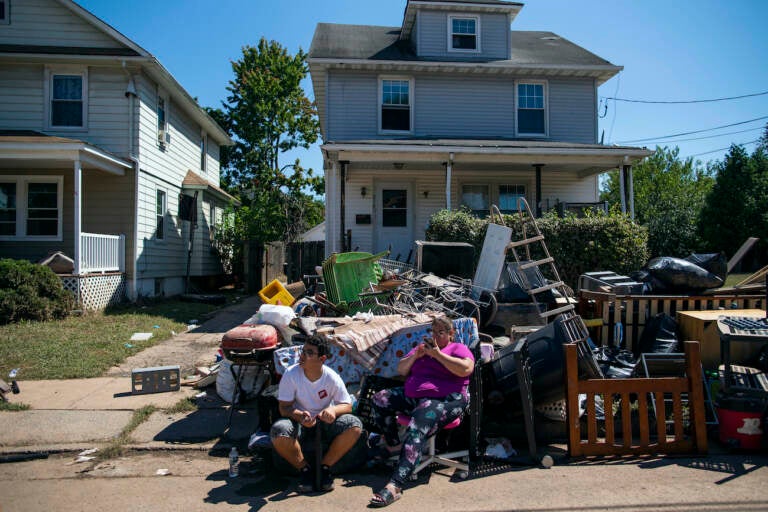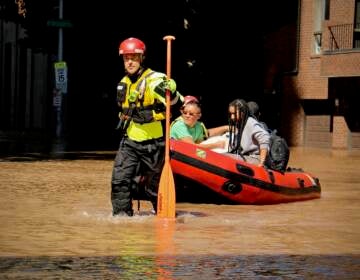New Jersey weighs expanding flood buyback program after Ida
New Jersey’s top environmental regulator said its floodplain property buyback program “definitely needs expansion” to help mitigate the effects of climate change.

Residents wait for President Joe Biden's motorcade to pass by one of the streets affected by Hurricane Ida in Manville, N.J., Tuesday, Sept. 7, 2021. (AP Photo/Eduardo Munoz Alvarez, File)
Liz Sawyer called Manville, New Jersey, home for more than two decades when Ida became the latest storm to send floodwaters crashing into her house. For her and her family it will — she hopes — be the last time.
“Let us get out of here,” Sawyer said during an interview this month, on the day President Joe Biden visited the storm-struck town. “This is our third flood. I have had enough. I’m done. I want to get out of here.”
Not even a month after Ida’s torrential leftovers dumped nearly a foot of rain in a few hours in places, turning roads into waterways and leaving 30 people dead in the state, New Jersey’s top environmental regulator said this week the state’s floodplain property buyback program “definitely needs expansion” as part of the state’s efforts to mitigate the effects of climate change.
Sawyer, a school bus driver, could be a beneficiary if New Jersey officials move ahead with the expansion of the program, known as Blue Acres. But the program isn’t a slam dunk for residents, who have to file applications and weigh whether a buyout makes financial sense for them.
Sawyer said she’s looking into the process already, and it’s daunting: There’s paperwork, lots of waiting and a fair amount of uncertainty. She’s also worried that she might have to sell her house on the market if the state’s offer isn’t enough.
“We have very little to no retirement,” she said. “This house is our future. Sadly.”
The expansion of the program, though, hinges in part on whether more federal money is allocated, said Department of Environmental Protection Commissioner Shawn LaTourette during a remote news conference. Democratic Gov. Phil Murphy also said this month that expanding the program should be on the table, but he stopped short of laying out a plan.
It could also be a challenge to persuade towns to participate. Support from local governments is one of the criteria the state considers when deciding whether to offer buyouts.
“For a community to come to terms with its risk and effectively say to itself that we have to uproot ourselves and find a new community… that is a big cultural undertaking,” he said.
In Little Falls, just west of Paterson, the town has had eight major flooding events from 2005 to 2011, according to the National Weather Service.
Nearly 150 homes in the town have been elevated or bought out through the state and FEMA since 2010, Mayor James Damiano said. He added that he favors elevations over buyouts for a number of reasons, including that homeowners who opt for elevation can expect significant reductions in their flood insurance costs, while buyouts cost the town over time in tax revenue.
New Jersey’s Blue Acres program began statewide in 2013 and has spent $200 million on buyouts as of February, the latest data available. The lion’s share of that funding, though, came from the federal government. The program has made offers on about 1,100 properties in 20 towns across the state, including Manville. About 700 houses have been demolished.
Manville sits along the Raritan and Millstone rivers and frequently gets hit hard by storms. The remnants of Tropical Storm Floyd brought catastrophic flooding in 1998, and the town sustained serious flooding during the aftermath of Hurricane Irene in 2011 and Superstorm Sandy in 2012. One low-lying section is known as the Lost Valley, which was hit hard by Ida and was where Biden toured.
Mark Nipps, a retired volunteer firefighter of 25 years and a Manville resident, pointed out the vacant lots recently where houses gobbled up through the program once stood.
“You hate to see your town disappear,” he said. “I don’t know if in my lifetime that section of town will be totally gone or if people just take a chance (and stay).”
Lou DeFazio, a contractor by trade and resident along with Sawyer in the Lost Valley, said he’s not leaving. It’s home, he said.
Over the past three decades, federal and local governments have poured more than $5 billion into buying tens of thousands of vulnerable properties across the country, according to an Associated Press analysis of data from the Federal Emergency Management Agency and the Department of Housing and Urban Development in 2019.
New Jersey ranked among the top states for federal money spent on flood buyouts of residential properties.
___
Associated Press writer David Porter in Little Falls, New Jersey, contributed to this report.
WHYY is your source for fact-based, in-depth journalism and information. As a nonprofit organization, we rely on financial support from readers like you. Please give today.





